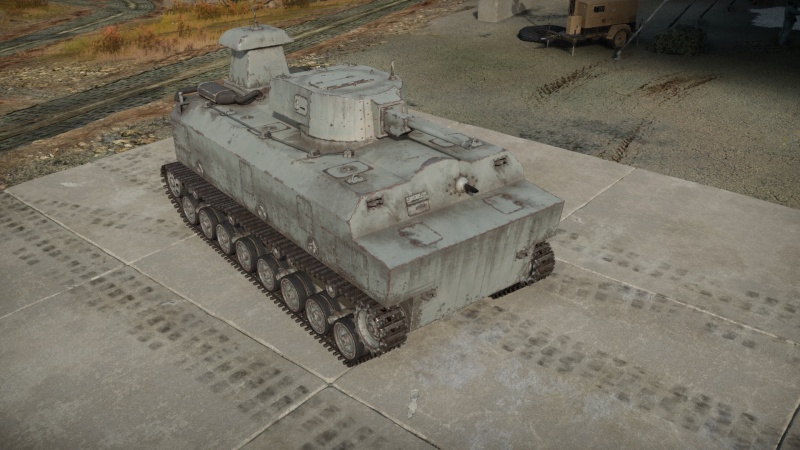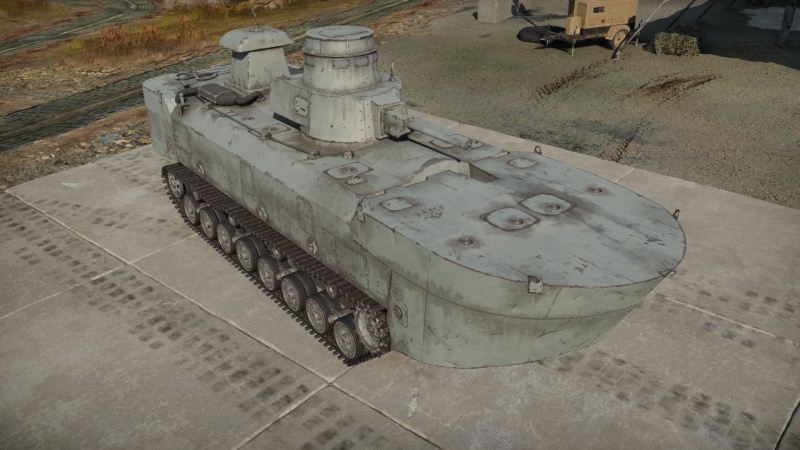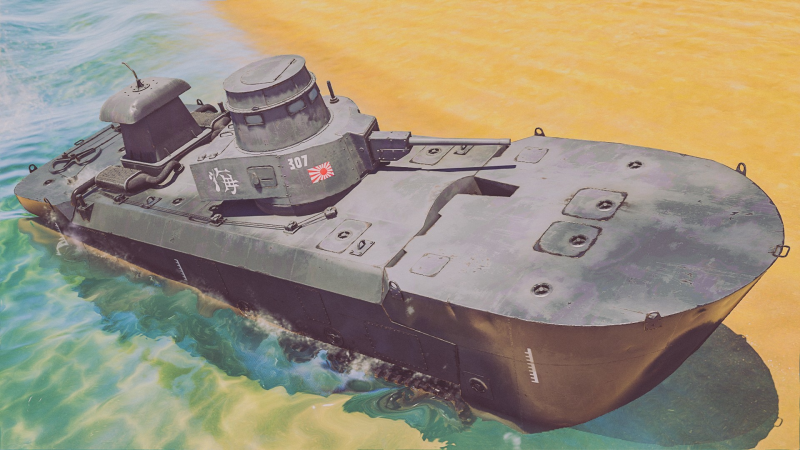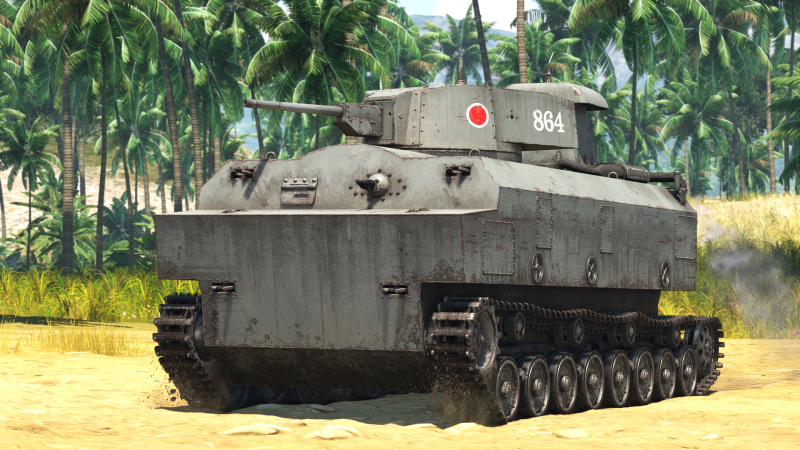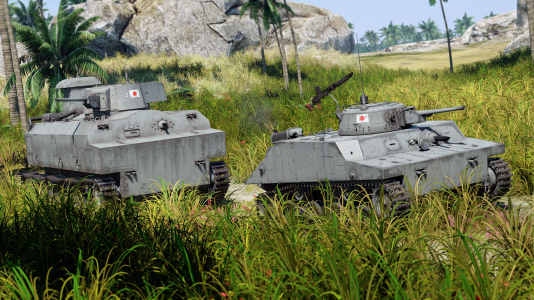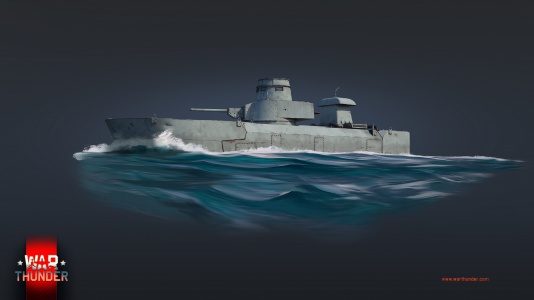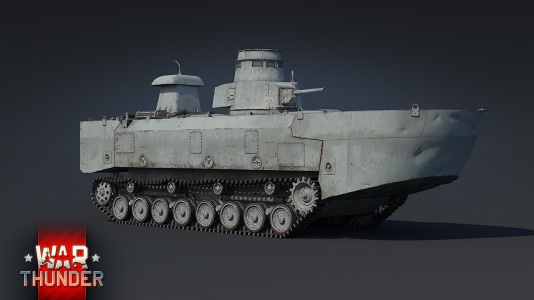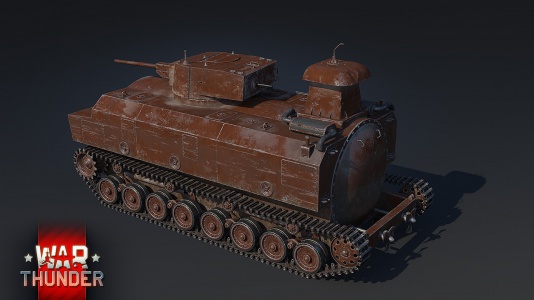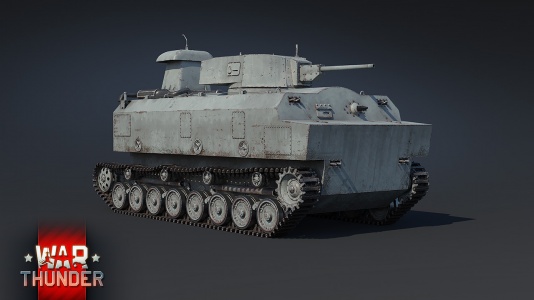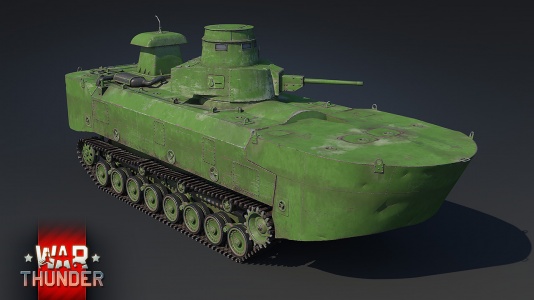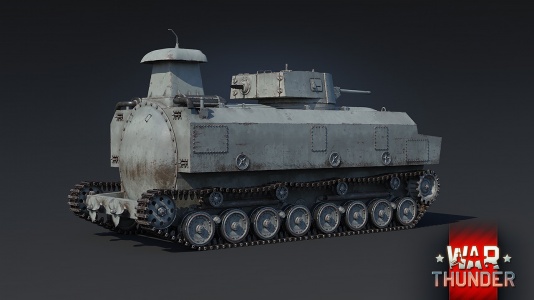Difference between revisions of "Ka-Chi"
(Additions/improvements to all text sections) (Tag: Visual edit) |
m (→Pros and cons) (Tag: Visual edit) |
||
| (16 intermediate revisions by 6 users not shown) | |||
| Line 1: | Line 1: | ||
{{Specs-Card | {{Specs-Card | ||
|code=jp_type_3_ka_chi | |code=jp_type_3_ka_chi | ||
| − | |images={{Specs-Card-Image|GarageImage_{{PAGENAME}}.jpg|ArtImage_{{PAGENAME}}.png}} | + | |images={{Specs-Card-Image|GarageImage_{{PAGENAME}}.jpg|GarageImage_{{PAGENAME}}_Floats.jpg|ArtImage_{{PAGENAME}}.png|ArtImage2_{{PAGENAME}}.png}} |
}} | }} | ||
== Description == | == Description == | ||
<!-- ''In the description, the first part should be about the history of the creation and combat usage of the vehicle, as well as its key features. In the second part, tell the reader about the ground vehicle in the game. Insert a screenshot of the vehicle, so that if the novice player does not remember the vehicle by name, he will immediately understand what kind of vehicle the article is talking about.'' --> | <!-- ''In the description, the first part should be about the history of the creation and combat usage of the vehicle, as well as its key features. In the second part, tell the reader about the ground vehicle in the game. Insert a screenshot of the vehicle, so that if the novice player does not remember the vehicle by name, he will immediately understand what kind of vehicle the article is talking about.'' --> | ||
| − | The '''{{Specs|name}}''' | + | The '''Special {{Specs|name}}''' ({{Annotation|特三式内火艇 「カチ」|Toku San-Shiki Uchibitei [Ka-Chi]}}) was an improvement program by the Navy over the [[Ka-Mi]], going larger and stronger using the [[Chi-He]] as a base instead of the Ha-Go. During development, the idea of making the tank transportable by submarine came up, allowing the tank to stealthily approach islands, emerge with the submarine, and offload into the water to then land on the island amphibiously. While a very potent tank and operationally interesting, during 1943-45 the Navy had more pressing issues on top of being on the defensive, diminishing the Ka-Chi's priority and use case. Only 12-19 were built and all were reserved for homeland defense. |
| − | + | The Ka-Chi was introduced during [[Update "Red Skies"]] as a reward for the [[wt:en/news/7267-event-summer-landing-en|2021 Summer Landing event]]. It may seem vaguely familiar to some Japanese tankers, as it is essentially a much larger, amphibious [[Chi-He]], featuring the same turret, maximum armour of 50 mm, and the same engine. Although the maximum armour is identical to that of the Chi-He, the Ka-Chi is significantly more survivable due to its enormous size, which spaces out more crew members, including two additional onboard engineers located behind the fighting compartment. Additionally, the mounted pontoons serve as extra spaced armour. However, these modifications strain the engine, which was not upgraded, resulting in slower mobility. Consequently, the Ka-Chi functions as an ad hoc assault tank, supposed to draw enemy fire with its large size, absorb shots, and push forward to engage enemy tanks with its decent 47 mm gun while providing support to allied forces. | |
== General info == | == General info == | ||
| Line 14: | Line 14: | ||
{{Specs-Tank-Armour}} | {{Specs-Tank-Armour}} | ||
<!-- ''Describe armour protection. Note the most well protected and key weak areas. Appreciate the layout of modules as well as the number and location of crew members. Is the level of armour protection sufficient, is the placement of modules helpful for survival in combat? If necessary use a visual template to indicate the most secure and weak zones of the armour.'' --> | <!-- ''Describe armour protection. Note the most well protected and key weak areas. Appreciate the layout of modules as well as the number and location of crew members. Is the level of armour protection sufficient, is the placement of modules helpful for survival in combat? If necessary use a visual template to indicate the most secure and weak zones of the armour.'' --> | ||
| − | At a first glimpse, the armour might look unappealing with weak sides but if one takes a literal dive in the armour profile it will become apparent that the tank isn't built like a conventional tank but like a submarine. It has a {{Annotation|light hull|The outer non-watertight hull which provides a hydrodynamically efficient shape}} and a {{Annotation|pressure hull|The inner hull of a submarine that maintains structural integrity with the difference between outside and inside pressure at depth.}} which both are 10 mm with air in-between, which can protect the tank from depths up to 100 m and tank cannons alike, even withstanding low-tier HEAT rounds of large | + | At a first glimpse, the armour might look unappealing with weak sides but if one takes a literal dive in the armour profile it will become apparent that the tank isn't built like a conventional tank but like a submarine. It has a {{Annotation|light hull|The outer non-watertight hull which provides a hydrodynamically efficient shape}} and a {{Annotation|pressure hull|The inner hull of a submarine that maintains structural integrity with the difference between outside and inside pressure at depth.}} which both are 10 mm with air in-between, which can protect the tank from depths up to 100 m and tank cannons alike, even withstanding low-tier HEAT rounds of large calibres. |
| − | The frontal armour of the Ka-Chi will look very similar to that of the Chi-He maxing out at 50 mm, which with installed pontoons, will become even better as the floats act like spaced | + | The frontal armour of the Ka-Chi will look very similar to that of the Chi-He maxing out at 50 mm, which with installed pontoons, will become even better as the floats act like spaced armour, defeating most HEAT & HE rounds and stopping some AP shells that lose their velocity before they reach the main hull. |
| − | The unconventional armour profile of this tank including the large spaced-out crew makes for a very survivable landship of a tank that shouldn't be messed around with. | + | The unconventional armour profile of this tank including the large spaced-out crew makes for a very survivable landship of a tank that shouldn't be messed around with. |
| − | Once pontoons are installed, they count as additional spaced armour for the front and back of the vehicle, stopping nearly any HEAT or HE shell from damaging the main hull. A large commander cupola is also installed, which doesn't connect to the turret as the hatch is closed. The cupola can be a fake weak spot that inexperienced players may target, thinking that a shot will kill a commander and splash down into the turret crew. Take note that is a legitimate concern when facing certain enemies like the [[15cm sIG 33 B Sfl]] and [[Spj fm/43-44]] as their large | + | Once pontoons are installed, they count as additional spaced armour for the front and back of the vehicle, stopping nearly any HEAT or HE shell from damaging the main hull. A large commander cupola is also installed, which doesn't connect to the turret as the hatch is closed. The cupola can be a fake weak spot that inexperienced players may target, thinking that a shot will kill a commander and splash down into the turret crew. Take note that is a legitimate concern when facing certain enemies like the [[15cm sIG 33 B Sfl]] and [[Spj fm/43-44]] as their large calibre HE shells can do exactly this. |
'''Armour type:''' | '''Armour type:''' | ||
| Line 38: | Line 38: | ||
* Tracks and suspension wheels are 20 mm thick. | * Tracks and suspension wheels are 20 mm thick. | ||
| − | * Front of turret has bolted on 25 mm armour to total up to 50 mm thick as the rest of the front. | + | * Front of the turret has bolted on 25 mm armour to total up to 50 mm thick as the rest of the front. |
| − | * The hull is built like a submarine, having an outer light hull and a pressure hull both 10 mm thick. | + | * The hull is built like a submarine, having an outer light hull and a pressure hull both 10 mm thick. |
=== Mobility === | === Mobility === | ||
| Line 45: | Line 45: | ||
<!-- ''Write about the mobility of the ground vehicle. Estimate the specific power and manoeuvrability, as well as the maximum speed forwards and backwards.'' --> | <!-- ''Write about the mobility of the ground vehicle. Estimate the specific power and manoeuvrability, as well as the maximum speed forwards and backwards.'' --> | ||
| − | {{tankMobility|abMinHp=372|rbMinHp=212}} | + | {{tankMobility|abMinHp=372|rbMinHp=212|AoAweight=2.3|weight=28.8}} |
While this tank might share the same engine as the Chi-He, it still is larger and heavier, resulting in less power-to-weight ratio and worse acceleration. With the big and bulky profile, it still can keep up with the slower medium and heavy tanks of its BR. Climbing hills and getting around corners will be slightly tougher than the average tank especially with pontoons installed. The extremely long length of the vehicle with floats can sometimes get the vehicle stuck on sharp angles and drops where the front and back pontoons get stuck on upper and lower ground and the tracks are unable to catch the ground. | While this tank might share the same engine as the Chi-He, it still is larger and heavier, resulting in less power-to-weight ratio and worse acceleration. With the big and bulky profile, it still can keep up with the slower medium and heavy tanks of its BR. Climbing hills and getting around corners will be slightly tougher than the average tank especially with pontoons installed. The extremely long length of the vehicle with floats can sometimes get the vehicle stuck on sharp angles and drops where the front and back pontoons get stuck on upper and lower ground and the tracks are unable to catch the ground. | ||
| − | The pontoons also add | + | The pontoons also add 2,300 kg of weight, resulting in worse mobility. It makes the amphibious Ka-Chi an even larger target than before, becoming the largest tank in the game in both length and height. Visibility is also a concern as the front pontoon completely blocks Driver's View. |
| − | The Ka-Chi is amphibious regardless of whether pontoons are installed or not | + | The Ka-Chi is amphibious regardless of whether pontoons are installed or not and can cross bodies of water by itself. The pontoons are for making the tank seaworthy, historically, and for forming a streamlined boat bow for the tank. The Ka-Chi can go 10 km/h (6mph) forwards in the water which is the high average for amphibious vehicles, and certainly faster than those that can't swim. |
=== Modifications and economy === | === Modifications and economy === | ||
| Line 84: | Line 84: | ||
==== Ammunition ==== | ==== Ammunition ==== | ||
| − | { | + | {{:Type 1 (47 mm)/Ammunition|Type 1 APHE}} |
| − | |||
| − | |||
| − | |||
| − | |||
| − | |||
| − | |||
| − | |||
| − | |||
| − | | Type 1 APHE | ||
| − | |||
| − | |||
| − | |||
| − | |||
| − | |||
| − | |||
| − | |||
| − | |||
| − | |||
| − | |||
| − | |||
| − | |||
| − | |||
| − | |||
| − | |||
| − | |||
| − | |||
| − | |||
| − | |||
==== [[Ammo racks]] ==== | ==== [[Ammo racks]] ==== | ||
| Line 131: | Line 103: | ||
'''Notes''': | '''Notes''': | ||
| − | * Shells are | + | * Shells are modelled individually in rack n°1 and disappear after having been shot or loaded. |
| − | * As they are | + | * As they are modelled by sets of 2, shells from racks 2 to 4 disappear from the rack only after you fire both shells in the set. |
=== Machine guns === | === Machine guns === | ||
| Line 139: | Line 111: | ||
{{main|Type 97 (7.7 mm)}} | {{main|Type 97 (7.7 mm)}} | ||
| − | The only functional machine gun mounted in the Ka-Chi is the hull-mounted bow machine gun which, once pontoons are installed, is disabled. Only once the pontoons are uninstalled can it be utilized, to very limited extents. It has a narrow arc of firing, a small clip size and only fires rifle-calibre bullets: just good enough to deal with trucks and exposed crews but not enough to penetrate a significant amount of | + | The only functional machine gun mounted in the Ka-Chi is the hull-mounted bow machine gun which, once pontoons are installed, is disabled. Only once the pontoons are uninstalled can it be utilized, to very limited extents. It has a narrow arc of firing, a small clip size and only fires rifle-calibre bullets: just good enough to deal with trucks and exposed crews but not enough to penetrate a significant amount of armour. It is up to the player to choose between more defensive armour or more offensive firepower. |
{| class="wikitable" style="text-align:center" width="50%" | {| class="wikitable" style="text-align:center" width="50%" | ||
| Line 153: | Line 125: | ||
== Usage in battles == | == Usage in battles == | ||
<!-- ''Describe the tactics of playing in the vehicle, the features of using vehicles in the team and advice on tactics. Refrain from creating a "guide" - do not impose a single point of view but instead give the reader food for thought. Describe the most dangerous enemies and give recommendations on fighting them. If necessary, note the specifics of the game in different modes (AB, RB, SB).'' --> | <!-- ''Describe the tactics of playing in the vehicle, the features of using vehicles in the team and advice on tactics. Refrain from creating a "guide" - do not impose a single point of view but instead give the reader food for thought. Describe the most dangerous enemies and give recommendations on fighting them. If necessary, note the specifics of the game in different modes (AB, RB, SB).'' --> | ||
| − | When downtiered, the tank can survive hits from most enemy shells at its BR. The surprisingly good armour and the good survivability make it a heavy tank. Its 47 mm gun won't have any trouble | + | When downtiered, the tank can survive hits from most enemy shells at its BR. The surprisingly good armour and the good survivability make it a heavy tank. Its 47 mm gun won't have any trouble penetrating the enemy armour at its BR. The Ka-Chi's armour is thick, but also flat: angling gives the tank a higher chance to bounce shells. |
When uptiered it should play as a support tank. Some enemy guns at the higher low-tier like the Russian [[ZIS-2 (57 mm)|ZIS-2]] and British [[6pdr OQF Mk.III (57 mm)|6pdr OQF Mk.III]] can penetrate the armour of the Ka-Chi without trouble (even when angled). The 47 mm cannon will also begin to struggle to penetrate enemy tanks. | When uptiered it should play as a support tank. Some enemy guns at the higher low-tier like the Russian [[ZIS-2 (57 mm)|ZIS-2]] and British [[6pdr OQF Mk.III (57 mm)|6pdr OQF Mk.III]] can penetrate the armour of the Ka-Chi without trouble (even when angled). The 47 mm cannon will also begin to struggle to penetrate enemy tanks. | ||
| − | In mixed ground battles, there is a high chance that planes will see you due to its large size so avoid open fields or large areas when planes are in the air. The ability to swim is not a big advantage but on some maps you can use it to flank the enemy. Swimming also allows the Ka-Chi to take a hull-down position, hiding most of its massive hull underwater. | + | In mixed ground battles, there is a high chance that planes will see you due to its large size so avoid open fields or large areas when planes are in the air. The ability to swim is not a big advantage but on some maps, you can use it to flank the enemy. Swimming also allows the Ka-Chi to take a hull-down position, hiding most of its massive hull underwater. |
| − | The very high mounting of the turret allows it to sit behind and shoot over things that most tanks cannot, such as large rocks, lumber piles, and steep hills. This means that it | + | The very high mounting of the turret allows it to sit behind and shoot over things that most tanks cannot, such as large rocks, lumber piles, and steep hills. This means that it can take hull-down positions that leave only the turret exposed, increasing survivability. One tactic is to use it as a sniper tank or mobile bunker. The punchy cannon and the ability to take unusual positions allows the Ka-Chi to hold down specific areas of the map quite easily. |
| − | Another tactic is to use the Ka-Chi as a breakthrough heavy tank. Although significantly | + | Another tactic is to use the Ka-Chi as a breakthrough heavy tank. Although significantly riskier, the survivability against low-calibre cannons and HE/HEAT resistance allows it to tank shots and push through enemy lines. Try to keep friendlies close and keep your enemies at a distance as a lone Ka-Chi is easily flanked and swarmed. |
The Ka-Chi, like a few other premium heavy vehicles of the rank such as the [[T-35]], [[B1 ter]] and [[Nb.Fz.|Neubaufahrzeug]] have an unwritten ability to rally friendly tanks when they charge. The stunning mass of the vehicle, its relative rarity, and the fact that it is used by more experienced players can inspire friendlies to group around the Ka-Chi as they are protected behind the large hull and can trust that the player using it will help lead them to victory. | The Ka-Chi, like a few other premium heavy vehicles of the rank such as the [[T-35]], [[B1 ter]] and [[Nb.Fz.|Neubaufahrzeug]] have an unwritten ability to rally friendly tanks when they charge. The stunning mass of the vehicle, its relative rarity, and the fact that it is used by more experienced players can inspire friendlies to group around the Ka-Chi as they are protected behind the large hull and can trust that the player using it will help lead them to victory. | ||
| Line 172: | Line 144: | ||
* Amphibious | * Amphibious | ||
* Very capable 47 mm Type 1 cannon, shoulder stabilized up to 12 km/h | * Very capable 47 mm Type 1 cannon, shoulder stabilized up to 12 km/h | ||
| − | * Submarine like side hull construction works as spaced armour, defeating low end HEAT and HE | + | * Submarine like side hull construction works as spaced armour, defeating low-end HEAT and HE |
| − | * Massive pontoons on the front and rear that can work as spaced | + | * Massive pontoons on the front and rear that can work as spaced armour |
* Large spacious crew compartment with 7 crew members being very survivable | * Large spacious crew compartment with 7 crew members being very survivable | ||
* Height allows it to shoot from behind large cover | * Height allows it to shoot from behind large cover | ||
| + | * 16.7 km/h reverse speed | ||
'''Cons:''' | '''Cons:''' | ||
* Very large target | * Very large target | ||
| − | * Overall thin armour on side and back only going up to 20 mm | + | * Overall thin armour on the side and back only going up to 20 mm |
* Poorer mobility and no driver visibility when equipped with pontoons. | * Poorer mobility and no driver visibility when equipped with pontoons. | ||
* No coaxial machine gun in the turret; hull machine gun is disabled when pontoons are equipped | * No coaxial machine gun in the turret; hull machine gun is disabled when pontoons are equipped | ||
| − | * | + | * Dead zones close to the hull and directly behind the turret where the cannon is unable to aim |
| + | * The 47mm Type 1 cannon has poor dispersion at longer ranges | ||
== History == | == History == | ||
<!-- ''Describe the history of the creation and combat usage of the vehicle in more detail than in the introduction. If the historical reference turns out to be too long, take it to a separate article, taking a link to the article about the vehicle and adding a block "/History" (example: <nowiki>https://wiki.warthunder.com/(Vehicle-name)/History</nowiki>) and add a link to it here using the <code>main</code> template. Be sure to reference text and sources by using <code><nowiki><ref></ref></nowiki></code>, as well as adding them at the end of the article with <code><nowiki><references /></nowiki></code>. This section may also include the vehicle's dev blog entry (if applicable) and the in-game encyclopedia description (under <code><nowiki>=== In-game description ===</nowiki></code>, also if applicable).'' --> | <!-- ''Describe the history of the creation and combat usage of the vehicle in more detail than in the introduction. If the historical reference turns out to be too long, take it to a separate article, taking a link to the article about the vehicle and adding a block "/History" (example: <nowiki>https://wiki.warthunder.com/(Vehicle-name)/History</nowiki>) and add a link to it here using the <code>main</code> template. Be sure to reference text and sources by using <code><nowiki><ref></ref></nowiki></code>, as well as adding them at the end of the article with <code><nowiki><references /></nowiki></code>. This section may also include the vehicle's dev blog entry (if applicable) and the in-game encyclopedia description (under <code><nowiki>=== In-game description ===</nowiki></code>, also if applicable).'' --> | ||
| − | With the success of the Navy's Type 2 Special Motorboat [[Ka-Mi]], a more ambitious project to create a bigger, more advanced vehicle was forwarded. Called the Type 3 Special Motorboat, it was not only meant as a fully ocean-going boat | + | With the success of the Navy's Type 2 Special Motorboat [[Ka-Mi]], a more ambitious project to create a bigger, more advanced vehicle was forwarded. Called the Type 3 Special Motorboat, it was not only meant as a fully ocean-going boat but capable of travelling submerged underwater as cargo on the back of a submarine. To withstand the depths (reported as deep as 100 m / 330 ft), the primary pressure hull was a cylinder between 2.0 and 2.1 m (6 ft 7 in) in diameter. Most of the machinery was taken from the [[Chi-He (Family)|Type 1 Chi-He]] medium tank, presumably to save costs and development time. Like the Ka-Mi, removable sea-going fore and aft pontoons were part of the design, however, they were not required to be amphibious. Navigation was accomplished by rudders attached to the rear pontoon. The vehicle-mounted twin screws could also be independently controlled to maintain a level of steering without the rudders. Nineteen units were reportedly built and extensively tested to success but were never used in combat as they were held back for the defence of the Japanese home islands. |
| + | |||
| + | ===[[wt:en/news/7264-development-summer-marathon-vehicles-type-3-ka-chi-en|Devblog]]=== | ||
| + | The adoption of the Ka-Mi amphibious tank design opened up interesting opportunities for the General Staff of the Imperial Japanese Navy, when during a landing from the sea, it became possible to provide fire support with tanks that could go into battle immediately from the sea. The light Ka-Mi, however, did not provide the necessary firepower and did not have sufficient protection. In 1943, a new amphibious tank was created on the basis of the quite successful Chi-He medium tank, which received the designation Type 3 Ka-Chi. To transform into an amphibious tank, the Chi-He underwent a rather deep modernization: the armor plates were dismantled, the suspension was lengthened, equipped with two additional pairs of road wheels and rollers, a tall snorkel appeared over the cover of the engine compartment, and a distinctive dome appeared over the commander's cupola. The Ka-Chi received front and rear pontoons, as well as a set of rubber plugs to seal the hull. The new amphibious tank successfully passed tests, however, by the beginning of mass production, the situation in the Pacific forced the naval authorities to concentrate all production capacity on the construction of new ships and carrier-based aircraft, therefore, by the end of the war, about two dozen Ka-Chi were produced, none of which were ever used in battle. | ||
== Media == | == Media == | ||
| Line 195: | Line 172: | ||
* [https://live.warthunder.com/feed/camouflages/?vehicle=jp_type_3_ka_chi Skins and camouflages for the {{PAGENAME}} from live.warthunder.com.] | * [https://live.warthunder.com/feed/camouflages/?vehicle=jp_type_3_ka_chi Skins and camouflages for the {{PAGENAME}} from live.warthunder.com.] | ||
| + | |||
| + | {{Skin-gallery | ||
| + | |market|ugcitem_1001053|Ka-Chi Improvised.jpeg|Camo "Ka-Chi Improvised Beach Landing" | ||
| + | }} | ||
;Images | ;Images | ||
| − | <gallery mode="packed-hover" heights=" | + | <gallery mode="packed-hover" heights="200px"> |
Ka-Chi (3).png|Two [[Ka-Chi|Type 3 Ka-Chi]]'s traveling through water | Ka-Chi (3).png|Two [[Ka-Chi|Type 3 Ka-Chi]]'s traveling through water | ||
Ka-Chi (2).png|A [[Ka-Chi|Type 3 Ka-Chi]] & [[Ka-Mi|Type 2 Ka-Mi]] landing ashore | Ka-Chi (2).png|A [[Ka-Chi|Type 3 Ka-Chi]] & [[Ka-Mi|Type 2 Ka-Mi]] landing ashore | ||
Ka-Chi (1).png|A [[Ka-Chi|Type 3 Ka-Chi]] & [[Ka-Mi|Type 2 Ka-Mi]] driving on land | Ka-Chi (1).png|A [[Ka-Chi|Type 3 Ka-Chi]] & [[Ka-Mi|Type 2 Ka-Mi]] driving on land | ||
| + | |||
| + | Ka-Chi_WTWallpaper001.jpg | ||
| + | Ka-Chi_WTWallpaper002.jpg | ||
| + | Ka-Chi_WTWallpaper003.jpg | ||
| + | Ka-Chi_WTWallpaper004.jpg | ||
| + | Ka-Chi_WTWallpaper005.jpg | ||
| + | Ka-Chi_WTWallpaper006.jpg | ||
</gallery> | </gallery> | ||
| Line 208: | Line 196: | ||
* ''links to approximate analogues of other nations and research trees.'' --> | * ''links to approximate analogues of other nations and research trees.'' --> | ||
| − | * [[Ka-Mi]] | + | ;Related Development |
| − | * [[ | + | |
| + | * [[Chi-He (Family)|Type 1 Chi-He]] (Based off) | ||
| + | * [[Ka-Mi|Type 1 Ka-Mi]] (Predecessor) | ||
| + | |||
| + | ;Tanks of comparable role, configuration, and era | ||
| + | |||
| + | * [[File:USA flag.png|30px|link=]] [[LVT(A)(1)]] | ||
== External links == | == External links == | ||
| Line 218: | Line 212: | ||
*[[wt:en/news/7264-development-summer-marathon-vehicles-type-3-ka-chi-en|[Development] Summer marathon vehicles: Type 3 Ka-Chi]] | *[[wt:en/news/7264-development-summer-marathon-vehicles-type-3-ka-chi-en|[Development] Summer marathon vehicles: Type 3 Ka-Chi]] | ||
| + | {{ShipManufacturer Yokosuka Naval Arsenal}} | ||
{{Japan medium tanks}} | {{Japan medium tanks}} | ||
{{Japan premium ground vehicles}} | {{Japan premium ground vehicles}} | ||
Latest revision as of 20:59, 19 October 2024
Contents
Description
The Special Type 3 Ka-Chi (特三式内火艇 「カチ」) was an improvement program by the Navy over the Ka-Mi, going larger and stronger using the Chi-He as a base instead of the Ha-Go. During development, the idea of making the tank transportable by submarine came up, allowing the tank to stealthily approach islands, emerge with the submarine, and offload into the water to then land on the island amphibiously. While a very potent tank and operationally interesting, during 1943-45 the Navy had more pressing issues on top of being on the defensive, diminishing the Ka-Chi's priority and use case. Only 12-19 were built and all were reserved for homeland defense.
The Ka-Chi was introduced during Update "Red Skies" as a reward for the 2021 Summer Landing event. It may seem vaguely familiar to some Japanese tankers, as it is essentially a much larger, amphibious Chi-He, featuring the same turret, maximum armour of 50 mm, and the same engine. Although the maximum armour is identical to that of the Chi-He, the Ka-Chi is significantly more survivable due to its enormous size, which spaces out more crew members, including two additional onboard engineers located behind the fighting compartment. Additionally, the mounted pontoons serve as extra spaced armour. However, these modifications strain the engine, which was not upgraded, resulting in slower mobility. Consequently, the Ka-Chi functions as an ad hoc assault tank, supposed to draw enemy fire with its large size, absorb shots, and push forward to engage enemy tanks with its decent 47 mm gun while providing support to allied forces.
General info
Survivability and armour
At a first glimpse, the armour might look unappealing with weak sides but if one takes a literal dive in the armour profile it will become apparent that the tank isn't built like a conventional tank but like a submarine. It has a light hull and a pressure hull which both are 10 mm with air in-between, which can protect the tank from depths up to 100 m and tank cannons alike, even withstanding low-tier HEAT rounds of large calibres.
The frontal armour of the Ka-Chi will look very similar to that of the Chi-He maxing out at 50 mm, which with installed pontoons, will become even better as the floats act like spaced armour, defeating most HEAT & HE rounds and stopping some AP shells that lose their velocity before they reach the main hull.
The unconventional armour profile of this tank including the large spaced-out crew makes for a very survivable landship of a tank that shouldn't be messed around with.
Once pontoons are installed, they count as additional spaced armour for the front and back of the vehicle, stopping nearly any HEAT or HE shell from damaging the main hull. A large commander cupola is also installed, which doesn't connect to the turret as the hatch is closed. The cupola can be a fake weak spot that inexperienced players may target, thinking that a shot will kill a commander and splash down into the turret crew. Take note that is a legitimate concern when facing certain enemies like the 15cm sIG 33 B Sfl and Spj fm/43-44 as their large calibre HE shells can do exactly this.
Armour type:
- Rolled homogeneous armour
| Armour | Front (Slope angle) | Sides | Rear | Roof |
|---|---|---|---|---|
| Hull | 50 mm (17°) Front plate 10 mm (85°) Front glacis 50 mm (9°) Joint plate 25 mm (54°) Lower glacis |
10 + 10 mm | 10 mm 20 mm Bulkhead |
10 mm |
| Turret | 25 + 25 mm (10°) Turret front 50 mm (0-10°) Gun mantlet |
25 mm (10°) | 25 mm Turret rear 50 mm (0-57°) Machine gun port |
12 mm |
Notes:
- Tracks and suspension wheels are 20 mm thick.
- Front of the turret has bolted on 25 mm armour to total up to 50 mm thick as the rest of the front.
- The hull is built like a submarine, having an outer light hull and a pressure hull both 10 mm thick.
Mobility
| Game Mode | Max Speed (km/h) | Weight (tons) | Engine power (horsepower) | Power-to-weight ratio (hp/ton) | ||||
|---|---|---|---|---|---|---|---|---|
| Forward | Reverse | Stock | AoA | Stock | Upgraded | Stock | Upgraded | |
| Arcade | 26.5 | 2.3 | 372 | 14.04 | __.__ | |||
| Realistic | 212 | 8 | __.__ | |||||
While this tank might share the same engine as the Chi-He, it still is larger and heavier, resulting in less power-to-weight ratio and worse acceleration. With the big and bulky profile, it still can keep up with the slower medium and heavy tanks of its BR. Climbing hills and getting around corners will be slightly tougher than the average tank especially with pontoons installed. The extremely long length of the vehicle with floats can sometimes get the vehicle stuck on sharp angles and drops where the front and back pontoons get stuck on upper and lower ground and the tracks are unable to catch the ground.
The pontoons also add 2,300 kg of weight, resulting in worse mobility. It makes the amphibious Ka-Chi an even larger target than before, becoming the largest tank in the game in both length and height. Visibility is also a concern as the front pontoon completely blocks Driver's View.
The Ka-Chi is amphibious regardless of whether pontoons are installed or not and can cross bodies of water by itself. The pontoons are for making the tank seaworthy, historically, and for forming a streamlined boat bow for the tank. The Ka-Chi can go 10 km/h (6mph) forwards in the water which is the high average for amphibious vehicles, and certainly faster than those that can't swim.
Modifications and economy
Armaments
Main armament
Comparatively to other light and medium tanks at this battle rating, the 47 mm Type 1 gun is quite surprising with 77 mm of penetration at point-blank range and has a good reload speed. Plus, this fires APHE shells, which deal great post-penetration damage. Comparatively, the 45 mm 20-K gun on Soviet tanks at ranks 1 and 2 has only 62 mm of penetration in similar conditions.
When the pontoons are installed, the cannon's maximum depression angle is reduced by 3°, making it harder to target close enemies in front of you.
| 47 mm Type 1 | Turret rotation speed (°/s) | Reloading rate (seconds) | |||||||||||
|---|---|---|---|---|---|---|---|---|---|---|---|---|---|
| Mode | Capacity | Vertical | Horizontal | Stabilizer | Stock | Upgraded | Full | Expert | Aced | Stock | Full | Expert | Aced |
| Arcade | 120 | -10°/+24° | ±180° | Shoulder | 14.3 | 19.8 | 24.0 | 26.5 | 28.2 | 4.29 | 3.80 | 3.50 | 3.30 |
| Realistic | 8.9 | 10.5 | 12.7 | 14.1 | 15.0 | ||||||||
Ammunition
| Penetration statistics | |||||||
|---|---|---|---|---|---|---|---|
| Ammunition | Type of warhead |
Penetration @ 0° Angle of Attack (mm) | |||||
| 10 m | 100 m | 500 m | 1,000 m | 1,500 m | 2,000 m | ||
| Type 1 APHE | APHE | 77 | 75 | 67 | 58 | 50 | 44 |
| Shell details | ||||||||||||
|---|---|---|---|---|---|---|---|---|---|---|---|---|
| Ammunition | Type of warhead |
Velocity (m/s) |
Projectile mass (kg) |
Fuse delay (m) |
Fuse sensitivity (mm) |
Explosive mass (TNT equivalent) (g) |
Ricochet | |||||
| 0% | 50% | 100% | ||||||||||
| Type 1 APHE | APHE | 808 | 1.49 | 1.2 | 9 | 22.4 | 47° | 60° | 65° | |||
Ammo racks
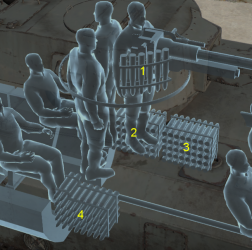
| Full ammo |
1st rack empty |
2nd rack empty |
3rd rack empty |
4th rack empty |
Visual discrepancy |
|---|---|---|---|---|---|
| 120 | 115 (+5) | 75 (+45) | 35 (+85) | 1 (+119) | No |
Notes:
- Shells are modelled individually in rack n°1 and disappear after having been shot or loaded.
- As they are modelled by sets of 2, shells from racks 2 to 4 disappear from the rack only after you fire both shells in the set.
Machine guns
The only functional machine gun mounted in the Ka-Chi is the hull-mounted bow machine gun which, once pontoons are installed, is disabled. Only once the pontoons are uninstalled can it be utilized, to very limited extents. It has a narrow arc of firing, a small clip size and only fires rifle-calibre bullets: just good enough to deal with trucks and exposed crews but not enough to penetrate a significant amount of armour. It is up to the player to choose between more defensive armour or more offensive firepower.
| 7.7 mm Type 97 | ||||
|---|---|---|---|---|
| Mount | Capacity (Belt) | Fire rate | Vertical | Horizontal |
| Hull | 4,000 (20) | 499 | ±5° | ±7° |
Usage in battles
When downtiered, the tank can survive hits from most enemy shells at its BR. The surprisingly good armour and the good survivability make it a heavy tank. Its 47 mm gun won't have any trouble penetrating the enemy armour at its BR. The Ka-Chi's armour is thick, but also flat: angling gives the tank a higher chance to bounce shells.
When uptiered it should play as a support tank. Some enemy guns at the higher low-tier like the Russian ZIS-2 and British 6pdr OQF Mk.III can penetrate the armour of the Ka-Chi without trouble (even when angled). The 47 mm cannon will also begin to struggle to penetrate enemy tanks.
In mixed ground battles, there is a high chance that planes will see you due to its large size so avoid open fields or large areas when planes are in the air. The ability to swim is not a big advantage but on some maps, you can use it to flank the enemy. Swimming also allows the Ka-Chi to take a hull-down position, hiding most of its massive hull underwater.
The very high mounting of the turret allows it to sit behind and shoot over things that most tanks cannot, such as large rocks, lumber piles, and steep hills. This means that it can take hull-down positions that leave only the turret exposed, increasing survivability. One tactic is to use it as a sniper tank or mobile bunker. The punchy cannon and the ability to take unusual positions allows the Ka-Chi to hold down specific areas of the map quite easily.
Another tactic is to use the Ka-Chi as a breakthrough heavy tank. Although significantly riskier, the survivability against low-calibre cannons and HE/HEAT resistance allows it to tank shots and push through enemy lines. Try to keep friendlies close and keep your enemies at a distance as a lone Ka-Chi is easily flanked and swarmed.
The Ka-Chi, like a few other premium heavy vehicles of the rank such as the T-35, B1 ter and Neubaufahrzeug have an unwritten ability to rally friendly tanks when they charge. The stunning mass of the vehicle, its relative rarity, and the fact that it is used by more experienced players can inspire friendlies to group around the Ka-Chi as they are protected behind the large hull and can trust that the player using it will help lead them to victory.
Pros and cons
Pros:
- Relatively strong frontal armour
- Amphibious
- Very capable 47 mm Type 1 cannon, shoulder stabilized up to 12 km/h
- Submarine like side hull construction works as spaced armour, defeating low-end HEAT and HE
- Massive pontoons on the front and rear that can work as spaced armour
- Large spacious crew compartment with 7 crew members being very survivable
- Height allows it to shoot from behind large cover
- 16.7 km/h reverse speed
Cons:
- Very large target
- Overall thin armour on the side and back only going up to 20 mm
- Poorer mobility and no driver visibility when equipped with pontoons.
- No coaxial machine gun in the turret; hull machine gun is disabled when pontoons are equipped
- Dead zones close to the hull and directly behind the turret where the cannon is unable to aim
- The 47mm Type 1 cannon has poor dispersion at longer ranges
History
With the success of the Navy's Type 2 Special Motorboat Ka-Mi, a more ambitious project to create a bigger, more advanced vehicle was forwarded. Called the Type 3 Special Motorboat, it was not only meant as a fully ocean-going boat but capable of travelling submerged underwater as cargo on the back of a submarine. To withstand the depths (reported as deep as 100 m / 330 ft), the primary pressure hull was a cylinder between 2.0 and 2.1 m (6 ft 7 in) in diameter. Most of the machinery was taken from the Type 1 Chi-He medium tank, presumably to save costs and development time. Like the Ka-Mi, removable sea-going fore and aft pontoons were part of the design, however, they were not required to be amphibious. Navigation was accomplished by rudders attached to the rear pontoon. The vehicle-mounted twin screws could also be independently controlled to maintain a level of steering without the rudders. Nineteen units were reportedly built and extensively tested to success but were never used in combat as they were held back for the defence of the Japanese home islands.
Devblog
The adoption of the Ka-Mi amphibious tank design opened up interesting opportunities for the General Staff of the Imperial Japanese Navy, when during a landing from the sea, it became possible to provide fire support with tanks that could go into battle immediately from the sea. The light Ka-Mi, however, did not provide the necessary firepower and did not have sufficient protection. In 1943, a new amphibious tank was created on the basis of the quite successful Chi-He medium tank, which received the designation Type 3 Ka-Chi. To transform into an amphibious tank, the Chi-He underwent a rather deep modernization: the armor plates were dismantled, the suspension was lengthened, equipped with two additional pairs of road wheels and rollers, a tall snorkel appeared over the cover of the engine compartment, and a distinctive dome appeared over the commander's cupola. The Ka-Chi received front and rear pontoons, as well as a set of rubber plugs to seal the hull. The new amphibious tank successfully passed tests, however, by the beginning of mass production, the situation in the Pacific forced the naval authorities to concentrate all production capacity on the construction of new ships and carrier-based aircraft, therefore, by the end of the war, about two dozen Ka-Chi were produced, none of which were ever used in battle.
Media
- Skins
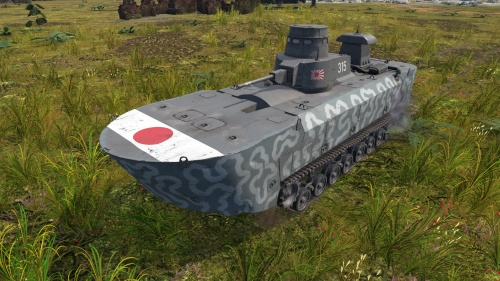
- Images
Two Type 3 Ka-Chi's traveling through water
A Type 3 Ka-Chi & Type 2 Ka-Mi landing ashore
A Type 3 Ka-Chi & Type 2 Ka-Mi driving on land
See also
- Related Development
- Type 1 Chi-He (Based off)
- Type 1 Ka-Mi (Predecessor)
- Tanks of comparable role, configuration, and era
External links
| Yokosuka Naval Arsenal (横須賀海軍工廠) | |
|---|---|
| Destroyers (DD) | |
| Momi-class | IJN Momi |
| Light Cruisers (CL) | |
| Mogami-class | IJN Suzuya |
| Heavy Cruisers (CA) | |
| Myōkō-class | IJN Myoko |
| Battlecruisers (BC) | |
| Kurama-class | IJN Kurama |
| Amagi-class | IJN Amagi |
| Battleships (BB) | |
| Fusō-class | IJN Yamashiro |
| Nagato-class | IJN Mutsu |
| Tanks | Ka-Mi · Ka-Chi · Chi-Ha LG |
| See also | Yokosuka Naval Air Technical Arsenal |
| Japan medium tanks | |
|---|---|
| Type 97 | Chi-Ha · Chi-Ha Kai · Chi-Ha Kai TD · Chi-Ha Short Gun |
| Type 1 | Chi-He · Chi-He (5th Regiment) · Ho-I |
| Type 3 | Chi-Nu · Chi-Nu II |
| Type 4 | Chi-To · Chi-To Late |
| Type 5 | Chi-Ri II |
| Type 61 MBT | ST-A1* · ST-A2* · ST-A3* · Type 61 |
| Type 74 MBT | ST-B2* · Type 74 (C) · Type 74 (E) · Type 74 (F) · Type 74 (G) |
| Type 90 MBT | Type 90 · Type 90 (B) · Type 90 (B) "Fuji" |
| Type 10 MBT | TKX (P)* · TKX* · Type 10 |
| Other | Ka-Chi |
| USA | ▅M4A3 (76) W · ▅M47 |
| *Prototype | |
| Japan premium ground vehicles | |
|---|---|
| Light tanks | Ha-Go Commander · Type 16 (FPS) |
| Medium tanks | Chi-Ha Short Gun · Chi-He (5th Regiment) · Ka-Chi · Chi-Nu II · Type 74 (G) · Type 90 (B) "Fuji" |
| Heavy tanks | Ro-Go · ▅Heavy Tank No.6 |
| Tank destroyers | Ho-Ri Prototype · Type 75 MLRS |



